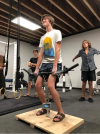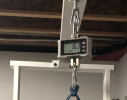It doesn't seem like there can any periodization of lower loads with overcoming isometrics. Push to the max at one angle for one block...
Isometric Periodization
Let's look at Functional Isometric Training that is employed with Training Loads, which is what I utilize.
Here is how my Isometric Periodization Warm Up are performed.
Warm Up Protocol
With each set the load is increased as well as the amount Intensity of the Isometric Action.
As each set increases in Loading, the amount of Isometric Tension once it hit the Upper Pin, increases it in order to keep the bar pressed into the Pins.
This method can be employed with a Non-Loaded Isometric. However, I have found Functional Isometrics mandates an increase of of Isometric Action Intensity as the Loading Increases.
The Periodization Training Cycle
This involves Progressively Loading with Heavier Loads with Functional Isometric Sets; as it does with Traditional Strength Training
Think of a Periodization Training Cycles like Warm Up.
Each week of a Periodization Training Cycle is a Warm Up for the following week.
The training objective is to prepare yourself for your Top Set on that particular Training Day.
The training objective of Periodization Training is to for the Final Week/Top Set in an Exercise; personal record.
This method can be employed with a Non-Loaded Isometric. However, it hard to measure.
However, one of the simplest method of measuring Isometric Force Production is with a...
Crain Scale
North Coast Miller mentioned using one.
This information was previously posted on this forum on using a Crane Scale to measure Isometric Force Production.
Maximizing Isometrics
So after this last Tactical Games, and looking forward to another one in August, I wanted to run a 6-8 week cycle where I focus 4 days per week on absolute strength and just getting strong, and then go back into my usual minimalist strength and heavy conditioning type thing. I had originally...
www.strongfirst.com


 Isometric Training Protocols: Exploring Variables Periodization and Training Recommendations
https://ijrpr.com/uploads/V4ISSUE5/IJRPR13664.pdf
Isometric Training Protocols: Exploring Variables Periodization and Training Recommendations
https://ijrpr.com/uploads/V4ISSUE5/IJRPR13664.pdf
This provide some good overall information, as well.
By manipulating variables such as intensity, duration, frequency, and contraction types, individuals can customize their training programs to suit their goals and fitness levels. Implementing a progressive overload strategy, incorporating variation in exercises and angles, and allowing for adequate rest and recovery are key factors in maximizing the benefits of isometric training. 


